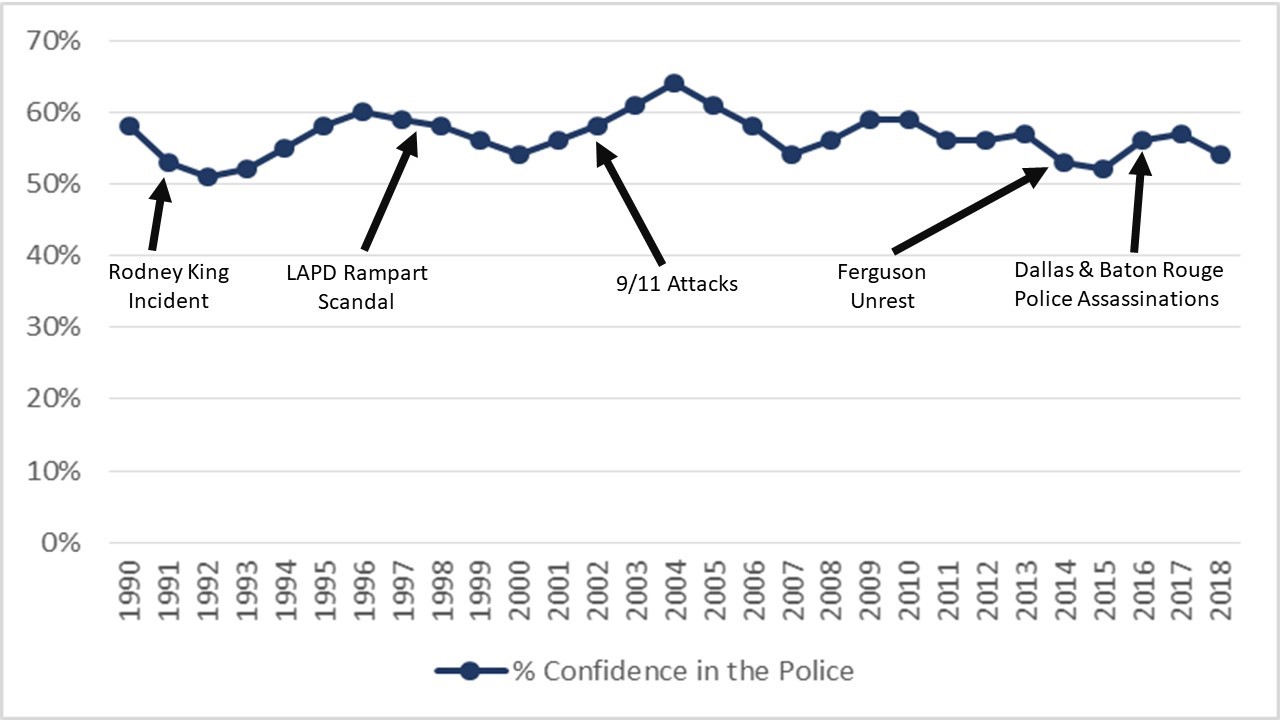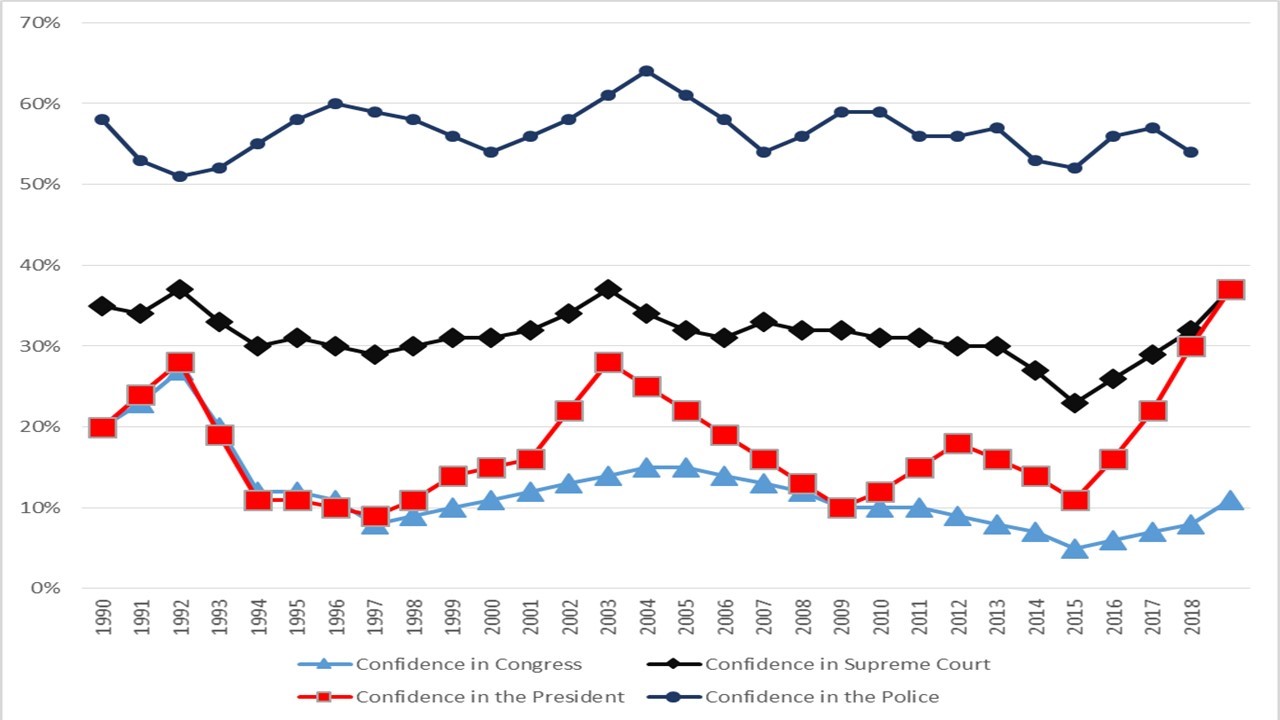We frequently see stories in the national news media about the public’s lack of trust in the police. When these stories move beyond anecdotal accounts, they often cite Gallup Poll data regarding public confidence in the police. For instance, much media attention was paid to the fact that public confidence in the police dipped to about 50% at the time of the unrest in Ferguson, Missouri in late 2014.
To be sure, a public confidence rate in which one out of every two Americans lacks confidence in the police is nothing to celebrate within our profession. Obviously, we wish for a higher confidence rate, like law enforcement had during the late 1960s when 7 out of 10 Americans had confidence in the police. But how does public confidence in law enforcement stack up against public confidence in other institutions, especially in recent years?
Graph 1 below shows the trend in Gallup Poll data on public confidence in the police from 1990 through the first half of 2018. This is a graph of the percentage of Americans surveyed by the Gallup Organization who indicated that they had “a great deal” or “quite a lot” of confidence in their local police, year by year. As one can see, since 1990, confidence in the police has fluctuated back and forth from about 50% to about 65%. When a sensational case of police use of force or corruption gets widespread national media attention, such as the Rodney King Incident (1991), the Rampart Scandal (1997), or the Ferguson Shooting (2014), public confidence in the police declines to near 50%. When national media attention lauds the police as heroes, such as in the aftermath of the 9/11 Attacks, or the mass assassinations of police officers during 2016, public confidence rises above 60%. Nevertheless, for the last 28 years, public confidence in the police bounced back and forth, but never fell below 50%, or rose above 65%.
Graph 1. Gallup Poll Data on Public Confidence in the Police (1990-2018)
While we would all like to see these numbers go higher, Americans have an inherent mistrust of all government institutions. Numerous surveys that have compared American attitudes with those of other Western democracies, such as Great Britain, France, Germany, Spain, and Japan, consistently reveal that Americans have the greatest cynicism towards government. Americans have historically wanted a minimum of government interference in their lives and tend to be suspicious of government.
So how does public confidence in law enforcement stack up against public confidence in other government institutions? Law enforcement in the U.S. is overwhelmingly a local government function, with 90% of law enforcement officers employed at the municipal or county level. The only other local government institution that the Gallup Poll has consistently included within its public confidence surveys has been public education. So how does public confidence in law enforcement compare to public confidence in public education since 1990?
Graph 2 compared the trend in public confidence in the police, with public confidence in public education, from 1990 through the first half of 2018. As this graph reveals, public confidence in public education has been below 50% since before 1990. Like law enforcement, public confidence in public education was in the 70% range during the late 1960s, but began to decline after 1973, and by 1990 had dropped below 50%.
Graph 2. Gallup Poll Data on Public Confidence in Police and Public Education (1990-2018)
While the national news media has remained relatively silent on these poll results, public confidence in public education has averaged 15 to 20 percentage points lower than that of public confidence in the police. This gap has also widened over time to the point where, for the first half of 2018, public confidence in public education is 36 percentage points lower than public confidence in the police. While public confidence in the police over the last 28 years has fluctuated between two points (50% and 65%), public confidence in public education has been much lower and continues a slow decline.
What about other government institutions? Graph 3 below reveals the levels of public confidence in the police alongside the levels of public confidence in Congress, the President, and the Supreme Court. As this graph reveals, since 1990, public confidence in law enforcement has remained much higher than the level of public confidence in the three pillars of the federal government. Even at its worst, public confidence in the police has been 12 percentage points higher than public confidence in the Supreme Court or the President at their best. The highest public confidence score Congress has received since 1990 is still 35 percentage points lower than the lowest public confidence score recorded for the police. Depending on the candidates they would like to bolster or tear down, the national news media outlets devote some attention to these federal government public confidence scores, but never in comparison to how much higher public confidence is in the police.
Graph 3. Gallup Poll Public Confidence in Police and Federal Government (1990-2018)
Undoubtedly the law enforcement professionals should continue to work hard to improve the public image of the police. Nevertheless, compared to other government institutions at the local and national level, it appears that the law enforcement profession is doing pretty well in terms of public confidence.
So why would the media focus so much attention on the “low” level of public confidence in the police? Might it be an effort to create a sensational story as a way to increase viewer ratings? This is likely, as there are a number of former mainstream media journalists who claim this sort of business strategy is used routinely. Television news and newspaper editors are constantly pressuring their field reporters to find the next “big scoop,” or to sensationalize boring, mundane stories. Law enforcement has clearly received more than its fair share of this sensationalizing over the last few years.
Regardless of the cause of the media’s focus on the perceived lack of confidence in the police, there is an irony in this focus—the level of confidence in the media itself is dismally low among the American people. Our final graph, Graph 4, compares the Gallup Poll data on public confidence in the police, with Gallup Poll data on public confidence in the television news media. In 1990 and 1991, law enforcement and the television news media had similar levels of public confidence – between 55% and 60%. After that, public confidence in the television news media took a major nose dive, dropping far below public confidence in the police, even in the midst of the Rodney King trial and riots that hurt law enforcement’s public image. Public confidence in television news media fell from 58% in 1990, to 33% in 1995. After its initial plummet in the early 1990s, public confidence in the television news media has never recovered.
Graph 4. Gallup Poll Public Confidence in Police and Television News (1990-2018)
After 1995, public confidence in television news has slowly declined further. Over the last 10 years, public confidence in the television news media has fluctuated between 20 and 28% – about 22 to 30 percentage points lower than the lowest recorded level of public confidence in the police. According to the Pew Research Institute, since 1990, newspaper readership (including online editions of newspapers) has been cut in half, declining by 51%. Network television news viewership has also declined by 43% since 1990.
In summary, public confidence in the police has remained fairly stable over the last 28 years, fluctuating between 50 and 65% from year to year. Nevertheless, confidence in the police has remained much higher than public confidence in other institutions with the isolated exceptions of the military and small business. Finally, for almost three decades, public confidence in the television news media (the prominent voice in public discourse decrying lack of public trust in the police) has been falling and is actually substantially lower than the level of public confidence in law enforcement.
These statistics demonstrate something fundamentally important: law enforcement officers are members of one of the most trusted institutions in our country—more than our news media, our public schools or our elected political bodies. There is a clear majority of the public that supports you and trusts in your work. That confidence is something to be protected through the professional execution of your duties as officers.
References
1 See, for example: https://www.washingtontimes.com/news/2014/aug/26/public-trust-police- low-poll-finds/ 2 Johnson, R. R. (2016). Why Officer Demeanor Matters. Raleigh, NC: Dolan Consulting Group. 3 Mauk, D., & Oakland, J. (2008). American Civilization: An Introduction. New York, Routledge. 4 Reaves, B. A. (2011). Census of State and Local Law Enforcement Agencies, 2008. Washington, DC: Bureau of Justice Statistics. 5 Attkisson, S. (2014). Stonewalled. New York, NY: Harper; Boynton, R. S. (2005). The New New Journalism: Conversations with America’s Best Nonfiction Writers on Their Craft. New York, NY: Vintage; Hersh, S. M. (2018). Reporter: A Memoir. New York, NY: Knopf. 6 Clarke, D. A., & Hannity, S. (2017). Cop Under Fire: Moving Beyond Hashtags of Race, Crime and Politics for a Better America. New York, NY: Worthy Publishing; Mac Donald, H. (2016). The War on Cops: How the New Attack on Law and Order Makes Everyone Less Safe. New York, NY: Encounter Books. 7 Pew Research Institute (2018): http://www.journalism.org/fact-sheet/newspapers/ 8 Engel, P. (2014, January 10). Most Americans don’t recognize America’s top evening news anchor. Business Insider. Downloaded at: https://www.businessinsider.com.au/most-americans- dont-recognize-americas-top-evening-news-anchor-2014-1




